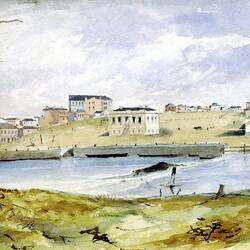Summary
Bamboo opium pipe, circa 1900s-1930s. Opium use was widespread in China between the 17th and 19th Centuries with the British East India Company importing large quantities of the drug. Chinese attempts to ban the opium trade and resistance against the foreign intervention it represented culminated in the Opium Wars of the early to mid-19th Century when force of arms ensured that Chinese ports remained open to opium.
Opium smoking followed Chinese migrants overseas, with the activity providing a means of relaxation and social interaction for a largely male community, who were often ostracised from the wider community. In 1867, a census of Chinese settlements in regional Victoria recorded at least 80 opium shops in 9 centres across regional Victoria. Opium smoking was legal in Victoria until 1905, although prior to this those who failed to pay import duties risked having supplies of opium confiscated.
Physical Description
Bamboo opium pipe with pottery bowl and ivory mouth piece.
More Information
-
Collecting Areas
Leisure, Migration & Cultural Diversity, Sustainable Futures
-
Acquisition Information
Purchase
-
Place & Date Used
-
Classification
Recreation & tourism, Substance use - opiates, Smoking equipment
-
Category
-
Discipline
-
Type of item
-
Exhibition Collection Management
580 mm (Length), 55 mm (Width), 85 mm (Height)
-
Dimensions
580 mm (Length), 56 mm (Width), 80 mm (Height)
Measurement From Conservation. Measuring Method: Max. dimensions as per conservation requirements.
-
Keywords
Chinese Communities, Chinese Immigration, Customs Houses, Immigration, Narcotic Drug Usage, Opium, Opium Smoking

